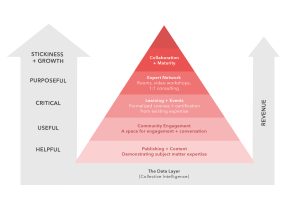6 best practices for building an online community
An increasing number of brands are turning to online communities in order to engage and delight their customers – and with so many benefits to the community approach, this is hardly a surprise. From activating meaningful participation from customers to their potential to boost ROI, online communities offer a competitive advantage in a saturated market. […]

An increasing number of brands are turning to online communities in order to engage and delight their customers – and with so many benefits to the community approach, this is hardly a surprise. From activating meaningful participation from customers to their potential to boost ROI, online communities offer a competitive advantage in a saturated market.
Building an onlinoe community from scratch can seem like an overwhelming task at first – particularly if you have limited experience in this area. What’s the best way to structure the layout? How do you keep members interested in returning? How should you look to drive revenue? Answering these questions can be a challenge, especially if there is pressure from above to get instant results.
Fortunately, we’re on hand to help. This list covers six of the most vital practices when building an online community, helping to get you on the path towards success in this major development for your organization. These practices include:
Best practices for building an online community
- Identify clear goals and KPIs
- Identify a community manager and dedicated staff
- Identify your core members
- Structure everything
- Activate participation
- Give your members all the highlights
Let’s dig into these a little deeper.
1. Identify clear goals and KPIs
Not every online community measures success in the same way. Different communities have different purposes, from knowledge-sharing, to product adoption, to hosting events. This means that when planning your own online community, it is important to have an idea of your goals and how you intend to measure them.
For some organizations, the purpose of building a community is to reduce support costs by encouraging knowledge-sharing between members. For the events industry, the goal might be to drive a higher number of registrations for future events. These goals can take any form, but it is crucial to establish them at the outset of the planning process so they can influence the design and building process.
One way of identifying your KPIs is the ABC method: Assess, Brainstorm, Choose. By taking a methodical approach and carefully considering the needs of your brand and stakeholders, it is easy to identify the key issues that your community needs to address.
Of course, the most important metric for the vast majority of brands is ROI. But in the early days of running an online community, any expectations of an immediate return on investment should be managed with caution. Focusing on more immediate goals such as boosting engagement will work wonders for the community in the long run, putting it on a path more likely to result in ROI further down the line.
2. Identify a community manager and dedicated staff
One of the most common pitfalls when starting an online community is the tendency to treat it as a side project. It can be tempting to jump on the bandwagon when a new marketing strategy emerges – but if your community is little more than a gimmick, your members will treat it as such.
Identifying a community manager is a vital early step in the planning process for any online community. This person will oversee the direction of content and shape the overall vision of the community, listening to feedback from members in order to better serve their needs. A community with a lot of members and activity may require additional staff, ensuring that questions are answered and conversations can be moderated carefully.
Where this role differs from a traditional social media manager is that community managers tend not to serve as the face of the brand they represent. A community manager will typically post on the community under their own account and name, participating in discussions and essentially behaving like other members. This allows them to build relationships with customers on a human level and extract greater insight to shape the community going forward.
Of course, it is not always possible for companies to hire a new community manager at the drop of a hat. If this is the case, we recommend dividing up the work of a community manager among a dedicated project team on a temporary basis until hiring a new member of staff becomes a viable option.
Managing an online community is a full-time job, and must be treated as such. The role of community manager should not be thrust upon someone with other responsibilities who will only be able to do it in their free time. The pivot to a community marketing strategy requires total buy-in from all levels of a company.
How to integrate social media and brand community marketing
3. Identify core members
With customer acquisition costs rising, it is more important than ever to keep existing customers happy and reduce churn.
With this in mind, an important step when planning an online community is to identify the core members. These are generally the people who are already invested in your brand and may have previously attended events in person. These members are typically people who are especially passionate about the topic of your community or possess a high level of expertise on the subject, making them key to your success further down the line. You will rely on them to share your content or promote the community via word-of-mouth, meaning it is imperative that their needs are met and they have nothing but good things to say about their user experience.
The members of an online community can generally be broken down into two groups: insiders and outsiders. Your insiders will typically amount to around 10-15% of your total membership and account for the majority of day-to-day activity within your community. Going to great lengths to make these members feel included and valued will encourage them to draw new members in over time and ensure that your community remains at the heart of customer conversations.
Though your core members will most likely be familiar with your brand and more comfortable contributing to the community than new members, it is still important to engage with these people from the outset. Reaching out with a personal invitation to join the community, along with a list of what they can expect to find there, will make these members feel as though they are playing an integral role in getting the community off the ground. Anything that creates a sense of emotional investment in the community such as this is worth doing.
4. Structure everything
Building and operating an online community is no small undertaking. It is a cultural shift for any brand that chooses to adopt it as a marketing strategy. It is therefore crucial that every step of the community-building process be carefully structured in advance.
Having these foundations in place will be particularly important when it comes to launch time. As that day approaches, there are a few questions you should be asking yourself. What content will be waiting for visitors on day one? How will members know where to go? What kind of a welcome will they receive from your staff?
A deciding factor in the success of any community launch is the user journey. If your community is confusing in its layout and content is not easy to find, members will quickly be turned off and discouraged from becoming active contributors. Creating distinct areas dedicated to specific topics is a key element when determining structure, breaking the main topic of your community down into sub-sections which might attract different users.
First impressions are everything, and online communities are no exception to this. Show your audience that you have a plan from day one, and you’ll get your community off to the best possible start. If they begin to suspect you don’t know what you’re doing, they’re unlikely to stick around – and even less likely to recommend the community to their friends and peers. So don’t cut any corners – you’ll be glad you didn’t further down the line.
5. Activating participation
The key to any thriving community is engagement. It’s not enough just to have your content seen by people – you need them to interact with it, share it and discuss it at length. Fortunately, online communities lend themselves perfectly to engagement on a number of levels.
The most basic level is customer insights, which can include surveys and feedback forms, but also spans across behavioral insights, polls and user groups. Online communities consolidate all of this in one hub, providing a more rounded view of the customer. One level up from this is customer engagement – or put simply, an interaction between brand and customer. Rather than broadcasting to customers, communities open up a dialogue, developing a trust which ultimately leads to brand loyalty and advocacy.
The third level of customer participation is co-creation, which means inviting customers to offer their advice and allowing them to contribute their own ideas and perspectives. From contests to user-generated content, customers’ ideas for a product or service can be woven into the creation process, ensuring that the end product is entirely customer-driven.
The most immersive form of participation is ‘customer as brand’, in which customers essentially become part of the brand itself. Scientific publisher Springer Nature uses its online communities to amplify the voices of researchers. Initiatives like ‘Behind the Paper’ invite them to tell their personal stories behind their research. This has become a core part of the Springer Nature USP and brand identity.
While it might be slightly too optimistic to expect masses of engagement with your community overnight, it can be useful to set targets at regular intervals in order to track progress. Remember to open up questions to your members and compel them to offer their thoughts at all times. Community members often need to be coaxed into making their first contributions, so lead by example and soon they should follow suit.
6. Give your members all the highlights
Of course, the aim is to build a community that is constantly abuzz with activity, both from its staff and its members. But as your community begins to take off, your members may find themselves struggling to keep up. The same goes for updates to your community platform; if there are new features to be shown off, you want to make sure everybody knows about them.
Offering a regular digest of all the big news from your community is a great way of reaching out to members, making them feel valued and pointing them in the direction of new opportunities to learn and participate with your brand.
It is easy to overthink the creation of your digest. After all, how are you to know what information your members will find useful? One solution is to create two digests: one for your top 10-15% of most active members, and another for the general community member. The version that goes out to your core members might feature a list of the latest or most popular content from the past month, as well as other nods in the direction of events or features that might be of interest. For more casual community members, the digest can simply be a basic rundown of what’s new, as well as any success stories that have come out of the community.
Building on solid foundations
There’s a lot to remember here. To put it simply, though: the difference between a successful online community and an unsuccessful one is planning. Be sure to follow these steps and ensure you have a plan of action in place for every step of your community’s journey, in order to limit the amount of things that can go wrong.
Remember that building and developing a community requires a great deal of patience. It won’t hit the heights you want it to overnight – but if you do everything right and focus on satisfying the customers you already have, that growth you’re so keen to see will surely follow.

We’re strong believers in a phased approach to online communities. Start with the basics – publishing useful content that your core members will appreciate. Over time, as your community expands, you can move onto events, webinars and eventually even one-to-one access to experts. No community opens on day one with a reputation for being a hub of expertise; that title has to be earned, and you’ve got to put in the hard yards to make it happen.
